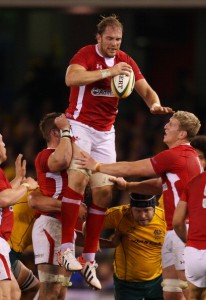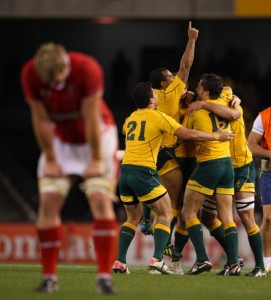By Paul Williams
It’s hard to win with 34% territory and 36% possession.
Wales came very close to beating the Wallabies on Saturday – you can’t come any closer. There were certainly positives that can be taken from the performance, most notably the defence. However, you can’t expect to beat Australia, in Australia, with 36% possession and 34% territory – it’s unrealistic. Poor tactical kicking resulted in Wales playing the majority of the game in their half, without the ball. Barring Wales’s first try, there were few multi-phase sets and no periods of sustained pressure in the red zone. Wales didn’t have a single attacking five-metre scrum or five-metre lineout. In fact, you can measure Wales’s lack of penetration into the Australian 22 by the average distances of Leigh Halfpenny’s penalty kicks – they were all taken from at least 35 yards out, unlike the Wallabies who had numerous attempts from around the 22m line.
Lineout collapse
Last week I wrote that Wales’s lineout woes had eased over the last 18 months. What’s that on my face? Yep, looks like egg. The Welsh lineout was unreliable against Australia. It functioned at 71.4% and paralysed Wales’s ability to gain any meaningful territory and depleted their ability to set up any scoring opportunities in the Wallaby red zone – the majority of tries in the modern game are scored from lineout possession. It seems cruel to blame one person for the failure; however Matthew Rees’s delivery was often inaccurate. If his selection in the starting line-up ahead of Ken Owens turned a few heads in the build-up to the game, his throwing-in turned a few stomachs.
Wales slowed Australia’s ball.
After witnessing the Wallabies’ ruck speed in the first test, which felt like watching the game on the SKY+ box switched to x6, Wales were very successful in slowing down the Australian ball in the second test. Wales’s key jackalers, Warburton and Jenkins, aligned themselves further from the ruck, ensuring the shortest line possible to the Australian breakdown – and it limited David Pocock’s impact to ‘super’ rather than ‘super human’. Wales also curtailed Will Genia, they often deployed the second ruck defender to run straight out of the line and block Genia’s ‘arcs’ that he likes to run from the back of the ruck. It was very effective.
Poor game management
Game management is an intangible skillset. It can’t be lifted in the gym and you won’t find it in lurking in a cryogenic ice chamber. It can only be honed by playing test matches and learning from those experiences and mistakes. If this holds true, Wales will have learned a lot on Saturday. Ashley Becks’ decision to ‘drift’ when the rest of the defensive line had blitzed created the Australian try. Wales decided to pass the ball wide and away from support during the last ten minutes, when neat, tight pod work was surely the answer to maintain possession and eat up the clock. I would mention the full list of game management errors, but that weighty tome can wait.
The bad news is actually good news.
The Wallabies had 64% possession and 66% territory. They made twice as many clean breaks as Wales and beat twice as many defenders. They ran nearly three times the distance with ball in hand, had a 100% record at the lineout and made nearly half the tackles. Yet Wales only lost by a penalty kick in the last minute. The point is, Wales didn’t play very well and lost narrowly to one of the ‘big three’, away from home. Of course, there will be those who read this and point out that Wales have yet again failed to turnover a Southern Hemisphere opponent, and to draw positives from a loss once again reinforces Wales’s role as plucky losers. But losses of this nature mean that big wins are just around the corner.
Follow Paul Williams on twitter @thepaulwilliams







